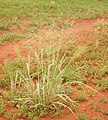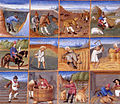Portal:Agriculture
The Agriculture Portal

Agriculture encompasses crop and livestock production, aquaculture, fisheries, and forestry for food and non-food products. Agriculture was the key development in the rise of sedentary human civilization, whereby farming of domesticated species created food surpluses that enabled people to live in cities. While humans started gathering grains at least 105,000 years ago, nascent farmers only began planting them around 11,500 years ago. Sheep, goats, pigs, and cattle were domesticated around 10,000 years ago. Plants were independently cultivated in at least 11 regions of the world. In the 20th century, industrial agriculture based on large-scale monocultures came to dominate agricultural output.
,
The major agricultural products can be broadly grouped into
. Global agricultural production amounts to approximately 11 billion tonnes of food, 32 million tonnes of natural fibres and 4 billion m3 of wood. However, around 14% of the world's food is lost from production before reaching the retail level.Modern
Selected article
The whole young pods of bean plants, if picked before the pods ripen and dry, are very tender and may be eaten cooked or raw. Thus the term "
.Beans are one of the longest-
Selected image

Did you know...
General images
-
In vitro-culture of Vitis (grapevine), Geisenheim Grape Breeding Institute (from Plant breeding)
-
Goat family with one-week-old kid (from Livestock)
-
Biomass distribution of humans, livestock, and other animals (from Livestock)
-
Native millet, Panicum decompositum, was planted and harvested by Indigenous Australians in eastern central Australia. (from History of agriculture)
-
Ancientrice terraces in Yuanyang County, Yunnan (from History of agriculture)
-
Pigs being loaded into their transport (from Livestock)
-
The Yecoro wheat (right) cultivar is sensitive to salinity, plants resulting from a hybrid cross with cultivar W4910 (left) show greater tolerance to high salinity (from Plant breeding)
-
Agricultural scenes of threshing, a grain store, harvesting with sickles, digging, tree-cutting and ploughing from Ancient Egypt. Tomb of Nakht, 15th century BC. (from History of agriculture)
-
An organic farmer, California, 1972 (from History of agriculture)
-
Indigenous Australian camp by Skinner Prout, 1876 (from History of agriculture)
-
Bt-toxins in genetically modified peanut leaves (bottom) protect from damage by corn borers (top). (from History of agriculture)
-
Jethro Tull's seed drill, invented in 1701 (from History of agriculture)
-
Sumerian harvester's sickle, 3000 BC, made from baked clay (from History of agriculture)
-
Agricultural calendar, c. 1470, from a manuscript ofPietro de Crescenzi (from History of agriculture)
-
Centres of origin identified by Nikolai Vavilov in the 1930s. Area 3 (grey) is no longer recognised as a centre of origin, and Papua New Guinea (red, 'P') was identified more recently. (from History of agriculture)
-
The agriculturalist Charles 'Turnip' Townshend introduced four-field crop rotation and the cultivation of turnips. (from History of agriculture)
-
Sheep in Écrins National Park (France) (from Livestock)
-
Clay and wood model of a bull cart carrying farm produce in large pots, Mohenjo-daro. The site was abandoned in the 19th century BC. (from History of agriculture)
-
Inca farmers using a human-powered foot plough (from History of agriculture)
-
Chronological dispersal of Austronesian peoples across the Indo-Pacific (from History of agriculture)
-
Noria wheels to lift water for irrigation and household use were among the technologies introduced to Europe via Al-Andalus in the medieval Islamic world. (from History of agriculture)
-
Pesticide application for chemical control of nematodes in a sunflower planted field. Karaisalı, Adana - Turkey. (from Agricultural safety and health)
-
The creation of maize fromteosinte (top), maize-teosinte hybrid (middle), to maize (bottom) (from History of agriculture)
-
Wichita village of grass houses surrounded by maize fields in the United States. (from History of agriculture)
-
An Indian farmer with a rock-weightedscratch plough pulled by two oxen. Similar ploughs were used throughout antiquity. (from History of agriculture)
-
Awaterwheel (from History of agriculture)
-
Selective breeding enlarged desired traits of the wild cabbage plant (cultivars of this plant. (from Plant breeding)
-
Magnified 100X, and stained with H&E (hematoxylin and eosin) staining technique, this light photomicrograph of brain tissue reveals the presence of prominent spongiotic changes in the cortex, and loss of neurons in a case of variant Creutzfeldt-Jakob disease (vCJD). (from Agricultural safety and health)
-
Agricultural research on potato plants (from Plant breeding)
-
Agriculture terraces were (and are) common in the austere, high-elevation environment of the Andes. (from History of agriculture)
-
Modern facilities in molecular biology are now used in plant breeding. (from Plant breeding)
-
Ploughing with a yoke of horned cattle in Ancient Egypt. Painting from the burial chamber of Sennedjem, c. 1200 BC. (from History of agriculture)
-
This Australian road sign uses the less common term "stock" for livestock. (from Livestock)
-
Livestock production requires large areas of land.
-
Roman harvesting machine, a vallus, from a Roman wall in Belgium, which was then part of the province of Gallia Belgica (from History of agriculture)
-
Global distribution data for cattle, buffaloes, horses, sheep, goats, pigs, chickens and ducks in 2010 (from Livestock)
-
The Occupational Safety & Health Administration logo. (from Agricultural safety and health)
-
Norman Borlaug, father of the Green Revolution of the 1970s, is credited with saving over a billion people worldwide from starvation. (from History of agriculture)
-
Garton's catalogue from 1902 (from Plant breeding)
-
A Fordson Dexta tractor with a rollover protection structure bar retro-fitted. (from Agricultural safety and health)
Related portals
Topics
Categories
Things you can do
WikiProjects

- WikiProject Horticulture and Gardening
- WikiProject Tree of lifeand its subprojects
- WikiProject Veterinary medicine
- WikiProject Food and drink
- WikiProject Forestry
- WikiProject Business and Economics
- WikiProject Companies
Associated Wikimedia
The following Wikimedia Foundation sister projects provide more on this subject:
-
Commons
Free media repository -
Wikibooks
Free textbooks and manuals -
Wikidata
Free knowledge base -
Wikinews
Free-content news -
Wikiquote
Collection of quotations -
Wikisource
Free-content library -
Wikiversity
Free learning tools -
Wiktionary
Dictionary and thesaurus
Agriculture journals

- Agronomy Journal - the American Society of Agronomy
- Agronomy for Sustainable Development Journal
- European Journal of Agronomy
- Journal of Agronomy and Crop Science
- Journal of Organic Systems
- Agriculture, Ecosystems & Environment
- Agriculture and Human Values
- Computers and Electronics in Agriculture
- Precision Agriculture
- Experimental Agriculture
- Journal of Integrative Agriculture
- Journal of the Science of Food and Agriculture
- Renewable Agriculture and Food Systems
- Biological Agriculture & Horticulture
See also:



































































